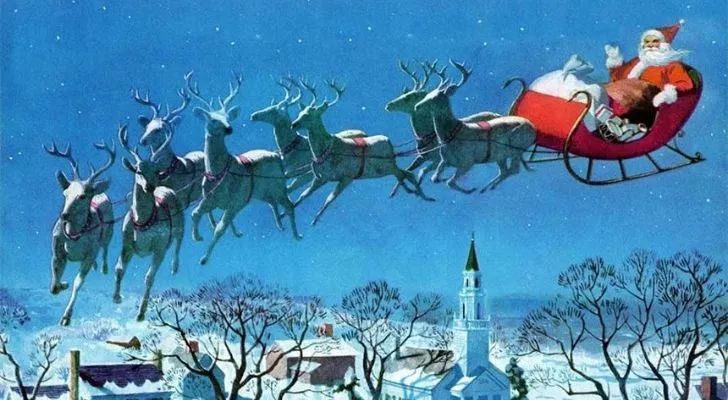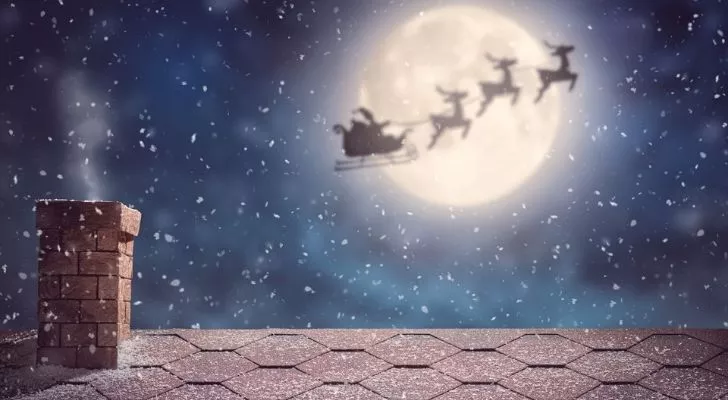Donner and Blitzen were originally known as Dunder and Blixem. These adorable animals are famous for pulling Santa’s sleigh during the holiday season and are beloved Christmas characters.
From movies and TV shows to Christmas cards and decorations, festivities just wouldn’t be the same without Santa’s reindeer. There are many interesting facts about these animals that you may not know, so keep reading to learn more and impress others at the dinner table this Christmas.
Santa Did Not Always Have Reindeer

Although Santa’s reindeer are now an essential part of the festive season, this was not always the case. The first reference to reindeer pulling a sleigh was made in 1821 by New York printer William Gilley, who published a collection of seasonal poems for children that referenced a reindeer pulling a sleigh.
Santa’s Reindeer Helped Reinvent His Image

Saint Nicholas had been part of Christmas traditions since the 13th century, but the character of Santa Claus with his bright red outfit and lively style appeared much later. The version of Santa that we know and love today evolved over decades, with Christmas poems and tales painting a picture of a jolly man with a white beard descending the chimney to leave gifts for well-behaved children. A sleigh pulled by adorable, hard-working reindeer brought even more magic to the revised story of Santa Claus. By the 1920s, Coca-Cola began using Santa Claus in its marketing.
The Author of the First Reindeer Poem is Unknown

Despite being a famous part of Christmas today, the author who wrote the poem that originally mentioned reindeer is not known. The poem, “Old Santeclaus with Much Delight,” depicted a reindeer pulling a sleigh carrying Santa over the rooftops and mentioned gifts being delivered on Christmas Eve instead of Saint Nicholas Day on December 6. Neither the author nor the illustrator of this legendary work is known. It is often shortened simply to “Old Santeclaus.”
Multiple Reindeer Were First Introduced in 1823

Two years after “Old Santeclaus” was published, an author anonymously released “A Visit from St. Nicholas,” which became commonly known as “The Night Before Christmas.” This 1823 publication, which first appeared in a New York newspaper, was claimed fourteen years later by American writer Clement Clarke Moore. It had a significant influence on developing modern-day Christmas tales and traditions, including Santa’s reindeer. It was the first time multiple reindeer had been named in a Christmas story. Dasher, Dancer, Prancer, Vixen, Comet, Cupid, Dunder, and Blixem were officially introduced into the history books.
Donner and Blitzen Used to Have Different Names

The original names of Santa’s reindeer in 1823 were Dunder and Blixem. Today, these reindeer are commonly known as Donner and Blitzen.
The names of Santa’s reindeer have a disputed history. “Dunder” and “Blitzen” are Dutch words for “thunder” and “lightning.” Charles Fenno Hoffman’s poem from 1837 originally named the reindeer “Donder” and “Blixen.” The reason for the change to “Donder” is unclear, but some speculate that “Blixen” was chosen to rhyme with “Vixen.” When Clement Clarke Moore included the poem in an 1844 publication, “Blixen” became “Blitzen,” and “Donder” was adopted. The transformation of “Donder” to “Donner” later on remains a mystery.
Rudolph was not one of the original reindeer and took over 100 years to appear. In 1939, a department store in Chicago commissioned Robert Lewis May to create a new Christmas character. Despite his wife’s cancer, May wrote “Rudolph the Red-Nosed Reindeer” in about 50 hours. The book was a success and millions of copies were given away to customers. Rudolph has since become a beloved Christmas character and was even featured in a number one song in America.
Contrary to popular belief, Santa’s reindeer are all female. Male reindeer shed their antlers after the mating season, but females retain theirs. Since the mating season is over by early December, reindeer seen with antlers during Christmas would most likely be female. Males use their antlers to fight during mating season, but if they are castrated, they would not typically shed their antlers. Female reindeer have more body fat than males, making them much warmer in sub-zero temperatures, which makes them better suited for pulling Santa’s sleigh through the air.
Although the original eight reindeer, plus Rudolph, are well-known, some people believe that Santa has other reindeer. In a 2002 episode of “South Park,” eight new reindeer formed a backup team after Santa’s sleigh was shot down. In the song “Santa is Watching You,” Ray Stevens lists the original reindeer plus George, Bill, Fred, Queenie, Bruce, and others.
The History of Santa’s Reindeer
For many years, Santa’s reindeer have been a beloved symbol of the holiday season. The original eight reindeer, including Rudolph, have a long-standing heritage dating back decades. Their story has become an integral part of Christmas tradition and continues to bring joy to people of all ages.
FAQ
1. How many reindeer does Santa have?
Santa Claus is said to have a team of eight reindeer that pull his sleigh, although Rudolph is sometimes included as a ninth member. The names of the traditional eight reindeer are Dasher, Dancer, Prancer, Vixen, Comet, Cupid, Donner, and Blitzen. These names were popularized in the poem “A Visit from St. Nicholas” by Clement Clarke Moore, also known as “The Night Before Christmas.”
2. Do reindeer really have red noses?
No, reindeer do not have red noses naturally. However, Rudolph’s red nose has become a symbol of the holiday season and has been popularized in songs, movies, and TV shows. The red nose is said to help guide Santa’s sleigh through foggy weather, making Rudolph an important member of the team.
3. Can reindeer really fly?
No, reindeer cannot fly in the traditional sense. However, they are known for being able to run and jump at impressive speeds, which could give the illusion of flight. In the context of Santa’s sleigh, it is said that the magic of Christmas allows the reindeer to fly through the air and deliver presents to children around the world.
4. Where do reindeer live?
Reindeer are native to the Arctic regions of Europe, Asia, and North America. They are well adapted to cold temperatures and have unique features such as large hooves for walking on snow and fur that changes color depending on the season. Reindeer are also known for their impressive migration patterns, which can cover thousands of miles each year.
5. What do reindeer eat?
Reindeer are herbivores and primarily eat lichens, mosses, and other vegetation found in their natural habitat. They have a specialized digestive system that allows them to break down tough plant material and extract nutrients from their food. In captivity, reindeer may also be fed hay, grains, and other supplements to ensure they receive a balanced diet.
6. Are reindeer endangered?
Some subspecies of reindeer are listed as threatened or endangered due to habitat loss, overhunting, and other factors. However, other populations of reindeer are considered stable or even overpopulated in certain regions. Conservation efforts are ongoing to protect reindeer populations and their habitat.
7. Are reindeer and caribou the same thing?
Reindeer and caribou are closely related and belong to the same species, but there are some differences between the two. Reindeer are domesticated and primarily found in Europe and Asia, while caribou are wild and primarily found in North America. Reindeer are also typically smaller and have shorter legs and broader snouts than caribou.

Zayn Anderson is a prolific writer with a passion for uncovering the world’s intriguing facts. Armed with an insatiable curiosity, he delves into various subjects, from history and science to nature and technology.
